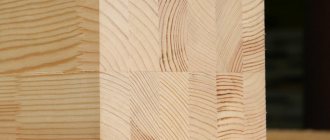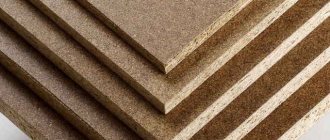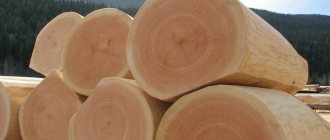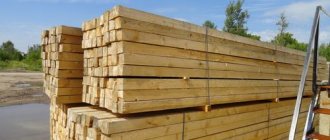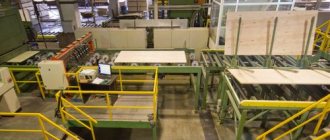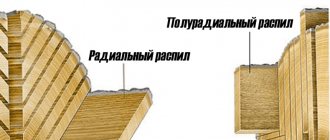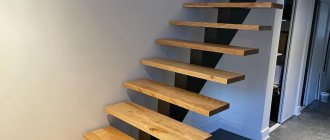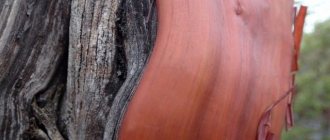In relation to the woodworking we are considering, this could be the production of sheathing boards or floor boards (finished products) from pine wood (raw material). Or the production of cabinet furniture from laminated chipboards.
At the same time, it is striking that the majority of technological processes in general and in woodworking in particular are complex processes, which in turn can be broken down into simpler ones.
Thus, the technological process for producing cladding boards from pine wood is divided into a set of technological processes for preparing the material (sawing, drying, giving the correct geometry, profiling, decorative coating) until the final product is completely ready.
In the case of the technological process for the production of cabinet furniture from laminated chipboards, this is a set of technological processes for manufacturing its parts, assembling them into the final product and equipping them with fittings until they are completely ready.
Thus, it is obvious that the final products or finished products obtained from wood are very diverse. They can consist of a large number of parts of different shapes and sizes. The parts themselves can be solid or consisting of other parts, as well as composite (glued). Each part also requires its own technological process for production.
Technological processes for processing parts consist of separate operations. An operation is usually called a process that occurs in relation to identical parts using unchanged means of labor. Operations can be divided into technological and auxiliary.
Technological operations are those during which parts change size, condition, shape and move within the workplace. These are, for example, planing, applying glue, milling, assembling and others like that. During auxiliary operations, the parts do not change - stacking, sorting, storage.
The workplace is an integral part of the technological process of wood processing. This is the name given to a certain part of the production facility on which the equipment, fixtures, materials and tools necessary to perform this operation are located. The order in which the necessary items are placed in the workplace is essential for the performance of any operation.
At modern woodworking enterprises, the technological processes for manufacturing wood products are mechanized. And the degree of mechanization, as a rule, depends on the volume of processing and, therefore, the size of the enterprise itself.
How to improve efficiency?
Sawmilling is a traditional craft for our country. But, compared to the past, modern equipment makes it possible to cut, dry and process wood not only better, but also faster. Wood processing industry today is aimed at increasing the efficiency of sawmilling through the introduction of new processing technologies and innovative equipment. As a result, many processes are becoming mechanized, old machines are being replaced with new models, lines for automatic wood processing with its rejection and sorting are being introduced.
Sawing features
Wood products are made from wood and processed in different ways depending on what exactly the woodworking industry is doing: logging, creating furniture and wood pulp, making paper, cardboard and products made from them, and so on. In general, the stages of the technological process can be described as follows:
- Wood harvesting. It is carried out on a specially selected area for logging.
- Sawing wood and sawing downed trees into logs.
- Rejection for the purpose of sorting large and small logs of different diameters.
- Already at the sawmill production plant, the primary processing of logs into lumber using circular or band saws. Here it must be said that the production of woodworking equipment today is carried out at an active pace, therefore woodworking occurs faster and better.
Let us consider the above-described technological stages in a little more detail.
Classification of production processes
The production system is based on production processes, the economic essence of which is the creation of added value. The deeper the degree of processing of raw materials, the higher the added value. The production process is understood as a set of labor and natural processes, as a result of the interaction of which raw materials are transformed into finished products. Production processes are classified according to many criteria, the main ones of which include:
- attitude to work: labor performed with human participation; natural;
- purpose: basic; auxiliary;
- batch size of labor items: single;
- serial: small-scale, medium-scale, large-scale; mass;
- nature of movement of objects of labor: continuous; discrete;
- stages: procurement; processing; assembly
At specialized sawmills, processing production processes with various batch sizes of labor items are implemented. Diversified sawmill and woodworking enterprises can include procurement (felling), processing (sawmilling, drying of lumber, mechanical processing of lumber, etc.), and assembly (for example, assembly of window blocks) processes.
The basis of the production process are technological processes, as a result of which the shape, size and/or properties of objects of labor change. As a result of performing an operation, for example, cutting a sawlog into lumber, its shape and dimensions change, and the operations of drying and impregnating wood are aimed at changing the properties of wood.
One of the main characteristics of the production process is the production cycle of products, the duration of which determines both labor productivity in an individual operation and the production capacity of the enterprise.
In accordance with the structure of the production process, the duration of the production cycle (Fig. 3) includes the time for performing technological operations, transporting the object of labor, monitoring its quality and storage duration. Thus, the production cycle for the production of dry edged lumber includes (if the raw materials are available in the warehouse) the time for determining the size and quality characteristics (sorting and accounting) of the sawlog, the time for transporting the sawlog to the debarking machine, the duration of debarking, the time for transporting the debarked sawlog to the log saw machine, duration of sawlog cutting into lumber, duration of transportation of lumber for further technological processing (removal of wane, trimming), time for processing lumber, duration of transportation of lumber to the sorting line (sorting area), time for transportation of lumber to the stacker and formation of a stack, loading duration lumber into the drying chamber, drying time of lumber, duration of unloading of lumber and holding it after drying, time for sorting, labeling and packaging of dry lumber. The main time spent is on drying lumber.
Analysis of the production cycle for the production of raw lumber shows that this process, based on classification characteristics, refers to simple, continuous processing processes with a low depth of raw material processing and relatively low added value.
Rice. 3. Production cycle for releasing a new product
Complex processes characterize the production of wood products, for example, window and door blocks, prefabricated wooden houses. The duration of the production cycle of complex processes is determined based on the duration of cycles of sequentially interconnected simple processes and inter-cycle breaks.
The production cycle of products is significantly lengthened for goods with a short life cycle (furniture), with frequent changes in assortment, and work on individual and small-scale orders (window and door units, furniture).
The organization of production processes is based on the following basic principles:
- technological specialization of flows of production items; straight-line movement of the production item (without return and loop-like movements), which is important to consider when placing equipment on the site, in the workshop;
- process flexibility, which allows you to produce a large range of products in one flow without additional time spent on equipment changeover;
- proportionality (multiple productivity of equipment included in one process);
- continuity (without creating buffer stocks);
- parallelism, i.e. simultaneous production of a complete set of parts based on a network process diagram;
- rhythmicity, ensuring the release of products of the same name at a certain time interval.
The main production processes of woodworking enterprises include:
Sawmill production:
- storage of raw materials;
- whip cutting;
- sawlog sorting;
- debarking of raw materials;
- sawmilling;
- processing and sorting of lumber, etc.
Plywood production:
- storage of raw materials;
- hydrothermal wood treatment;
- debarking and cutting of raw materials;
- peeling and drying of veneer;
- veneer gluing and plywood processing;
- sorting, labeling and packaging of products, etc.
Production of joinery and construction products and furniture:
- primary mechanical processing, usually cutting;
- gluing and veneering;
- secondary mechanical processing;
- assembly (packing);
- creation of protective and decorative coatings.
The main technological directions for the preparation of woodworking industries are the following:
A. Sawmill production:
- justification of the volumetric, quality and assortment output of sawlogs from the log;
- cutting optimization;
- justification of volumetric, quality and assortment output of lumber;
- cutting optimization;
- justification of wood drying regimes;
- optimization of cutting lumber into blanks;
- study of lumber variety formation;
- research into the accuracy and quality of lumber processing;
- justification of materials and parameters of protective treatment regimes for lumber (antiseptic, anti-pyretic treatment, etc.), etc.
B. Plywood production:
- justification of the quantitative and qualitative yield of veneer from the block;
- justification of the parameters of hydrothermal processing of wood, peeling, drying and gluing of veneer;
- optimization of veneer thickness sets;
- study of the properties of plywood and other veneer materials; research and justification of the formulation of adhesives and protective and decorative materials;
- research and justification of the structure of layered veneer materials;
- research into the grading of plywood and other veneer materials, etc.
B. Production of joinery and construction products:
- justification of the volume and quality output of lumber blanks;
- study of the strength and deformation of individual elements and assembly units of window and door units;
- study of processing accuracy and surface roughness of parts;
- study of thermal, noise-absorbing and other characteristics of window and door units;
- research and justification of the formulation of adhesives and protective and decorative materials;
- justification of standards for the consumption of raw materials and materials, etc.
G. Furniture production:
- research and justification of architectural and artistic solutions, ergonomic and anthropometric characteristics of furniture products;
- study of the strength characteristics of products and their individual elements;
- research into the reliability and stability of products;
- study of the mechanical properties of individual parts and assembly units of furniture products (strength of tenon joints, softness of elements, etc.);
- research and justification of the formulation of adhesives and paints and varnishes;
- study of the dimensional accuracy of individual elements, assembly units and products;
- justification of consumption rates for raw materials and materials, etc.
Cutting and drying
These two processes are closely related, and they can follow in different sequences in an enterprise. Most often, the wood is dried directly in boards, and the lumber is cut into blanks already dry. As experts note, if drying is carried out in boards, then the output is 2-3% more lumber. In addition, cutting already dried boards allows you to promptly notice defects and flaws in the wood and reject unsuitable elements.
The technology of woodworking production involves drying in several ways, but most often - either atmospheric or using special chambers. Atmospheric drying is a long process that involves storing wood in the open air. The use of drying equipment allows you to speed up the logging process. It is worth remembering that the quality of the final construction depends on the degree of drying of the lumber.
What technologies?
Modern woodworking production involves processing harvested wood in different ways. Note that any mechanical wood processing process involves complex cutting. But, depending on the technological goals, the woodworking process can be reduced to three actions:
- Wood and wood-based materials undergo division.
- All elements undergo surface treatment, during which technological allowances are removed.
- Materials undergo deep processing, during which finishing blanks are transformed into finished product parts.
Wood division can occur with or without the formation of waste chips. During surface processing, work is carried out on milling, grinding and turning, while in depth processing, drilling, in-depth milling and chiselling are performed. Each of these processes has its own characteristics. Sawing, milling, peeling, grinding, turning, drilling - all these are technologies on the basis of which any woodworking industry operates. A ladder-support for plants, by the way, is the first product that schoolchildren create during a technology lesson in the fourth grade. It is at this age that children become familiar with the woodworking process.
Technological processes in the manufacture of joinery and furniture products.
Now, from general words about the technological processes of manufacturing wood products, we can move on to considering specific examples, namely the production of joinery and furniture products.
The operation of drying lumber and veneer before sending it to production is one of the first stages of the technological process at enterprises using these materials.
The next important operation is cutting lumber into pieces of certain sizes, from which parts are then obtained. Such blanks after cutting are called rough blanks. The cutting operation can be carried out both before and after drying; everything here depends on the size and design of the workpieces and final products.
This is followed by the operation of machining the workpieces; it is usually divided into two stages. At the first stage, the workpieces are processed from four sides along the cross-section and given the final length, ensuring the correct geometric shape and dimensional accuracy. This stage is called mechanical processing of rough blanks; the result of its implementation is finishing blanks.
At the second stage of machining of workpieces, spikes and lugs are formed on the parts, holes are drilled, nests are selected, grinding, etc. This is the stage of mechanical processing of finishing workpieces, the result of which is finished parts.
Two stages of mechanical processing, one after the other, are typical for enterprises using solid wood blanks. If, for the manufacture of the final product, composite (glued) parts or parts that require additional special coating are used, then the technological process is supplemented with gluing or veneering operations.
The assembly operations of finished products can also be divided into several stages. At the first stage of the assembly operation, parts can be assembled into assembly units (frames, panels, boxes, etc.). At the next stage, the assembly units are subjected to additional processing to eliminate sagging, adjust dimensions and, if necessary, drill out sockets. The final stage is the final general assembly of the final product.
The finishing operation can be performed before or after the overall assembly of the final product.
The above listed operations, stages and stages of operations, in turn, are divided into simpler operations. For example, the operation of cutting boards into rough blanks includes sawing the boards lengthwise and cross-cutting, and when using glued blanks in the production, the operation of removing knots is also added. This may be preceded by the operation of preliminary marking of the board.
The operation is not some strictly regulated part of the technological process in woodworking. For example, in small woodworking enterprises, the assembly of parts into products can be performed by one worker at one workplace as one operation. At large enterprises, assembly can be divided into several independent operations performed by individual workers or teams at different workplaces.
This division of the operation, called differentiation, helps to increase labor productivity.
Protective measures
Wood is a material that is not resistant to external natural factors. That is why any enterprise that works with wood must take protective measures. Their task is to prevent the destruction of wood and protect it from fire, fungus, and mold. As part of these measures, not only thorough drying of the material is carried out, but also chemical treatment using antiseptics. In most cases, sawmills and woodworking industries use oil-based antiseptics and varnishes that do not dissolve in water for these purposes. Treatment is carried out with wood tar, creosote oil, carboleum.
What is being produced?
Modern wood processing enterprises strive to optimize their technologies in order to obtain a larger volume of final products using less wood. Woodworking production allows you to obtain a wide variety of end products:
- MDF boards. For their production, industrial waste is used, which is ground and treated with steam under high pressure - the mass is wiped, then dried and glued together.
- Slatted timber. This semi-finished product is obtained by gluing slats from already dried wood.
- Chipboard boards. They are panels with a uniform thickness, which are based on shavings mixed with binder materials.
- Plywood. It consists of sheets of wood of different thicknesses, which are glued together with special adhesives.
What machines?
Woodworking machines for production are presented in a huge variety and can perform a wide variety of work related to material processing. Popular equipment includes:
- Combination machines are multi-purpose equipment capable of sawing, planing, drilling, tenoning, and so on. These machines are used for complex processing of blanks made of natural wood or its waste.
- Lathes process the workpiece by cutting and turning, cutting threads, processing ends, and drilling holes.
- Band saws make it possible to perform straight or shaped sawing of materials. The blade in such equipment is a continuous metal strip with teeth.
- Milling machines perform work along guide lines, while the material is supplied manually. The use of such equipment is advisable in profile, planar and shaped processing of wood blanks.
- A drilling machine allows you to process holes by removing chips;
- Format cutting machines allow you to cut slab materials individually or serially.
- Circular saws are tools that have hard teeth that can cut wood.
This is only a small part of the machines that are used in woodworking. With their help, you can create lumber, blanks, semi-finished products, which are further used in construction, furniture and other fields.
Woodworking production is divided into the following types of wood processing - mechanical, chemical, biological, hydrothermal, and all this is united by the forest processing industry. In addition to the wood processing industry , it includes the pulp and paper, wood chemical and hydrolysis industries.
The pulp and paper industry unites production facilities producing pulp, paper, and cardboard. The peculiarity of these industries is the grinding of wood to fiber size and the production of the necessary products from the fiber. In products made from shredded wood, it is difficult to recognize the original product - wood.
The wood chemical industry unites industries involved in the chemical processing of wood, which results in completely new substances that are not similar to wood. Using wood, the forest chemical industry produces more than 80 types of products, including charcoal, phenolic products, rosin, turpentine, acetone, acetic acid, and formaldehyde.
The hydrolysis industry is engaged in microbiological processing of wood. Its main products are ethyl alcohol, necessary for the production of synthetic rubber, feed yeast, furfural, solid carbon dioxide (dry ice), etc. The woodworking industry unites a large group of woodworking industries associated with the processing and processing of wood. According to the raw materials consumed and the products produced, they can be divided into three groups: according to the production of semi-finished products (raw materials - logs, logs, logs, vanches; semi-finished products); for the production of wood products (raw materials - semi-finished products; finished products of complex design; special production.
Group of production facilities for the production of semi-finished products. Wood removed from the forest in the form of sticks, logs, and ridges is processed at wood processing enterprises. This group includes the following productions:
- Sawmills, where logs are used to make boards, bars, blanks, and industrial chips. The main type of processing is sawing, milling, drying; The main products are semi-finished wood products.
- Manufactures producing parts for wooden houses. The main type of processing is sawing, milling, drying; products - timber and panel elements of wooden houses.
- Production of laminated laminated wood. This group includes industries producing veneer, plywood, plywood boards, wood-laminated plastics, plywood pipes, wood panels, and laminated veneer lumber. The main types of processing are peeling, drying, gluing; The main products are semi-finished products.
- Production of particle boards and fibreboards. The main type of processing is wood grinding, drying, pressing; products - semi-finished products.
A distinctive feature of woodworking industries engaged in primary wood processing is the raw materials consumed - products of logging enterprises. For the first three industries, the raw material is industrial wood, for industries producing slabs, low-quality wood and industrial chips.
Group of production facilities for the production of wood products. Further processing of the main part of semi-finished products is carried out at enterprises belonging to the group of production facilities for the production of wood products. Consumed raw materials are products of production of semi-finished products: boards, particle boards and fibreboards, plywood, veneer, glued blanks. Manufactured products are products suitable for direct use (cabinets, tables, pianos, doors, window frames, etc.).
This group includes industries producing: furniture, construction units and parts; prefabricated wooden houses; wooden musical instruments; housings and cases for radios, televisions, watches, microscopes; wooden ships; parts, components, assemblies and products for the equipment of railway cars, motor ships, agricultural machines, motor vehicles; Sports Equipment.
The products produced by these factories are distinguished by their complex design and multi-part nature. The main method of joining wooden parts into units is carpentry and gluing. Finished products in most cases have protective and decorative coatings.
Group of special woodworking industries . This group conventionally includes production in which round wood and semi-finished products are used as raw materials, and the design of the product is relatively simple. These are match, pencil, cooper, convoy, shuttle-reel, container and other industries. The special group also includes production of wood waste processing and the production of wood flour, fiberboard, wood concrete and other board materials, parts from a chip-adhesive mixture.
Types of enterprises. Currently, from the considered industries, various types of enterprises have emerged. Specialized enterprises are enterprises specializing in the production of certain products. Sawmills produce sawmill products, plywood - laminated laminated materials. This includes furniture factories, musical instrument factories, etc.
Combines are enterprises that combine various industries: sawmills, plywood, furniture, particle boards. This combination, in addition to more rational use of wood, allows for better use of labor, electrical energy, fuel, and transport.
Forestry complexes are enterprises that combine production not only for wood processing, but also for its processing and full integrated use in pulp and paper, wood chemical and hydrolysis industries. The scope of activity of timber industry complexes includes not only the procurement and processing of wood, but also the renewal of its reserves. In addition, it is possible to process branches, bark, needles, and stumps, which makes it possible to comprehensively use the entire biological mass of a growing tree.
conclusions
It should be noted that every year both the technologies and equipment used for wood processing become more and more advanced. And this, in turn, makes it possible to create a wide variety of products from this natural material. Let us note that even in school, especially in elementary school, woodworking production is studied. The product “Ladder-support for plants” is the first thing a child can create as early as the fourth grade. This allows children to be taught at a young age how to carefully handle wood and nature in general and to draw attention to logging and woodworking as one of the actively developing areas in Russia.
Process design procedures for production systems
The main procedures for technological design and production preparation are:
- analysis of products planned for release based on marketing and technological research;
- analysis of raw materials and supplies;
- production capacity calculations;
- analysis of standard technological processes, advanced equipment and technology, organization of work;
- determination of the sequence and content of technological operations;
- selection of equipment and its calculation;
- development of options for individual technological processes and their
- analysis;
- choosing the optimal option;
- analysis and development of process control systems;
- development of technological instructions, selection, justification and calculations
- processing modes;
- selection and calculations of tools and technological equipment;
- selection and calculations of vehicles;
- calculations of the areas of workplaces, in-shop warehouses, auxiliary departments of the workshop;
- development of a workshop plan with the location of equipment;
- determination of the professional composition of the main workers;
- calculations of operational production standards and time standards;
- calculations of consumption rates for raw materials and materials;
- calculations of the average product grade coefficient;
- calculations of consumption rates of auxiliary materials
- calculations of the required amount of electricity, steam, compressed air, fuel and water for technological needs;
- establishing criteria for assessing the quality of technological operations, semi-finished products and products;
- establishment of forms, methods and means of quality control;
- organization of control;
- development of the fundamentals of raw material accounting systems;
- analysis of the main types of defects and causes of defects, development of measures to prevent them;
- analysis of labor intensity and production costs;
- analysis of occupational safety and environment.
455
